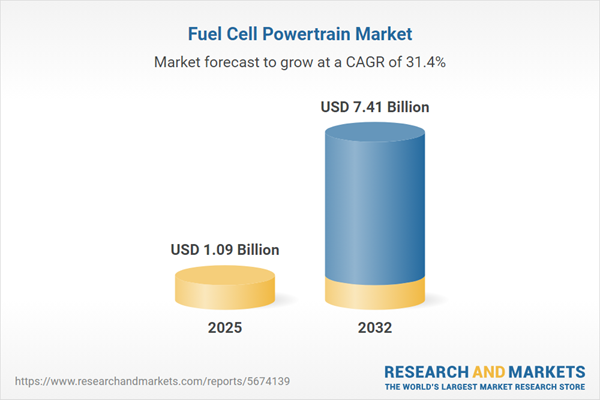Speak directly to the analyst to clarify any post sales queries you may have.
The fuel cell powertrain market stands at the intersection of innovation and resilience, emerging as an essential pathway for organizations seeking to meet growing sustainability and compliance demands in a changing energy landscape.
Market Snapshot: Fuel Cell Powertrain Market Size & Growth
The global fuel cell powertrain market continues to display robust momentum, with a valuation of USD 835.99 million in 2024. Forecasts suggest expansion to USD 1.09 billion in 2025, and a significant increase to USD 7.41 billion by 2032, supported by a compound annual growth rate of 31.37%. Close cooperation between manufacturers and regulators, improved supply chain integration, and sustained infrastructure investments are pivotal in sustaining this trajectory. Adoption is spreading across transportation, stationary energy, and allied industries as organizations recalibrate portfolios and strategies for cleaner energy solutions.
Scope & Segmentation of the Fuel Cell Powertrain Market
- Technology Types: Encompasses alkaline, direct methanol, molten carbonate, phosphoric acid, proton exchange membrane, and solid oxide fuel cell systems. These technologies serve varied operational needs: alkaline and direct methanol excel in specific energy settings, while proton exchange membrane and solid oxide types meet the requirements for mobile and stationary applications. This range supports flexible deployment strategies for diverse organizations.
- Applications: Offers solutions for the automotive sector—spanning commercial vehicles, buses, and passenger fleets. Extends to portable power across telecommunications, electronics, and critical infrastructure, including defense, commercial, and residential segments, enabling organizations to align with clean power objectives.
- Power Output: Provides under 5 kW units for compact uses, 5–50 kW models for vehicles and remote operations, and above 50 kW systems for fleet or energy infrastructure, supporting scalability and targeted adoption.
- Components: Includes essential modules such as fuel cell stacks and control electronics, along with advanced subsystems managing air, hydrogen, heat, and water—driving operational efficiency and adaptability.
- End Users: Targets government agencies, industrial and commercial operators, and utilities. These users capitalize on improved efficiency, regulatory compliance, and access to government incentives, enhancing their operational value.
- Regions: Reports notable growth in the Americas, Europe, Middle East & Africa, and Asia-Pacific. The United States, Canada, Germany, China, India, and Japan drive innovation and supply chain leadership, reflecting regional investment priorities in clean energy.
- Key Companies Analyzed: Examines strategies and market progress from Ballard Power Systems Inc., Plug Power Inc., Doosan Fuel Cell Co., Ltd., Bloom Energy Corporation, FuelCell Energy, Inc., Ceres Power Holdings plc, AFC Energy plc, SFC Energy AG, Intelligent Energy PLC, and Toshiba Corporation. Their advances influence sector trends, technology breakthroughs, and commercial partnerships.
Key Takeaways for Senior Decision-Makers
- Organizations are evolving from small-scale pilots to scaled implementations, broadening the impact and reach of fuel cell powertrain solutions in mainstream operations.
- Material innovations and advances in catalyst science contribute to sustainability objectives while enhancing the durability and real-world performance of both legacy and emerging energy systems.
- Localized supply chain and production models are being adopted, reducing regional risk and effectively addressing diverse regulatory landscapes and customer expectations.
- Collaboration between public and private sectors is accelerating the development of hydrogen infrastructure, transforming isolated projects into commercial-scale initiatives with wider reach.
- Decision-makers are leveraging tailored solutions—such as proton exchange membrane systems for mobile applications and solid oxide for stationary projects—to optimize investment and regulatory alignment.
- Strategic decisions are increasingly supported by robust case studies and advanced analytics, allowing leaders to respond swiftly to evolving requirements and end-user dynamics.
Tariff Impact: United States 2025 Tariffs and Supply Chain Response
Upcoming tariffs in the United States, effective in 2025, are prompting industry participants to reconfigure procurement and sourcing strategies. Manufacturers, including several based in Asia, are exploring investment in North American production capabilities. U.S. organizations are adapting sourcing plans to maintain cost efficiency and maximize available incentives, bolstering market resilience and enhancing competitive positioning amid shifting trade policies.
Methodology & Data Sources
This analysis leverages direct interviews with manufacturers and supply chain specialists. Findings are validated with shipment data, reviews by academic and regulatory experts, technical audits, and patent assessments. This comprehensive approach delivers stakeholders a dependable strategic foundation for decision-making.
Why This Fuel Cell Powertrain Market Report Matters
- Enables executive teams to benchmark initiatives and respond dynamically to evolving technology trends, regulatory demands, and fuel cell powertrain market shifts.
- Offers actionable insights to refine supply chain performance, guide targeted R&D investment, and support strategies focused on long-term compliance and competitiveness.
- Facilitates proactive risk management while highlighting new growth opportunities as organizations increase their adoption of global clean energy solutions.
Conclusion
Understanding the fuel cell powertrain market empowers organizations to align operations with sustainability and resilience goals. Staying informed on emerging developments and standards ensures readiness for ongoing energy sector transformation.
Additional Product Information:
- Purchase of this report includes 1 year online access with quarterly updates.
- This report can be updated on request. Please contact our Customer Experience team using the Ask a Question widget on our website.
Table of Contents
3. Executive Summary
4. Market Overview
7. Cumulative Impact of Artificial Intelligence 2025
Companies Mentioned
The companies profiled in this Fuel Cell Powertrain market report include:- Ballard Power Systems Inc.
- Plug Power Inc.
- Doosan Fuel Cell Co., Ltd.
- Bloom Energy Corporation
- FuelCell Energy, Inc.
- Ceres Power Holdings PLC
- AFC Energy PLC
- SFC Energy AG
- Intelligent Energy PLC
- Toshiba Corporation
Table Information
| Report Attribute | Details |
|---|---|
| No. of Pages | 188 |
| Published | November 2025 |
| Forecast Period | 2025 - 2032 |
| Estimated Market Value ( USD | $ 1.09 Billion |
| Forecasted Market Value ( USD | $ 7.41 Billion |
| Compound Annual Growth Rate | 31.3% |
| Regions Covered | Global |
| No. of Companies Mentioned | 11 |









